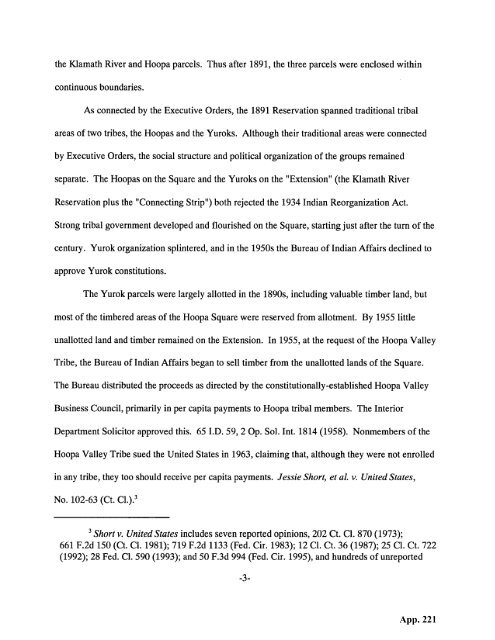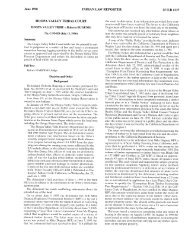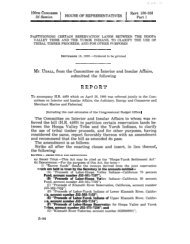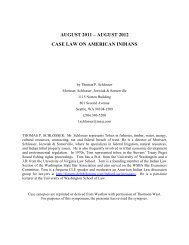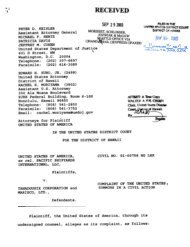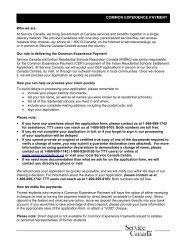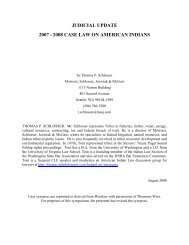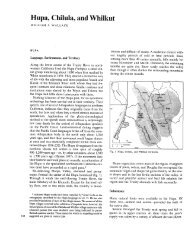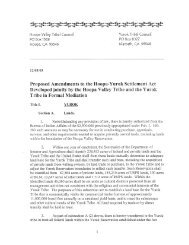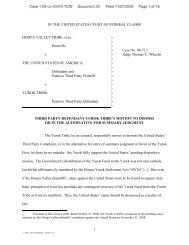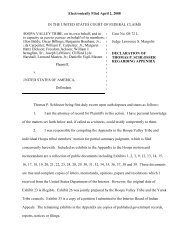Hoopa appendix supporting summary judgment - Schlosser Law Files
Hoopa appendix supporting summary judgment - Schlosser Law Files
Hoopa appendix supporting summary judgment - Schlosser Law Files
Create successful ePaper yourself
Turn your PDF publications into a flip-book with our unique Google optimized e-Paper software.
the Kiamath River and <strong>Hoopa</strong> parcels. Thus after 1891, the three parcels were enclosed within<br />
continuous boundaries.<br />
As connected by the Executive Orders, the 1891 Reservation spanned traditional tribal<br />
areas of two tribes, the <strong>Hoopa</strong>s and the Yuroks. Although their traditional areas were connected<br />
by Executive Orders, the social structure and political organization of the groups remained<br />
separate. The <strong>Hoopa</strong>s on the Square and the Yuroks on the “Extension” (the Klamath River<br />
Reservation plus the “Connecting Strip”) both rejected the 1934 Indian Reorganization Act.<br />
Strong tribal government developed and flourished on the Square, startingjust after the turn of the<br />
century. Yurok organization splintered, and in the 1950s the Bureau of Indian Affairs declined to<br />
approve Yurok constitutions.<br />
The Yurok parcels were largely allotted in the 1890s, including valuable timber land, but<br />
most of the timbered areas of the <strong>Hoopa</strong> Square were reserved from allotment. By 1955 little<br />
unallotted land and timber remained on the Extension. In 1955, at the request of the <strong>Hoopa</strong> Valley<br />
Tribe, the Bureau ofIndian Affairs began to sell timber from the unallotted lands of the Square.<br />
The Bureau distributed the proceeds as directed by the constitutionally-established <strong>Hoopa</strong> Valley<br />
Business Council, primarily in per capita payments to <strong>Hoopa</strong> tribal members. The Interior<br />
Department Solicitor approved this. 65 I.D. 59, 2 Op. So!. Int. 1814 (1958). Nonmembers of the<br />
<strong>Hoopa</strong> Valley Tribe sued the United States in 1963, claiming that, although they were not enrolled<br />
in any tribe, they too should receive per capita payments. Jessie Short, et al. v. United States,<br />
No. 102-63 (Ct. Cl.). 3<br />
~Short v. United States includes seven reported opinions, 202 Ct. Cl. 870 (1973);<br />
661 F.2d 150 (Ct. Cl. 1981); 719 F.2d 1133 (Fed. Cir. 1983); 12 Cl. Ct. 36 (1987); 25 Cl. Ct. 722<br />
(1992); 28 Fed. Cl. 590 (1993); and 50 F.3d 994 (Fed. Cir. 1995), and hundreds of unreported<br />
-3-


